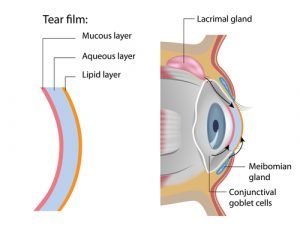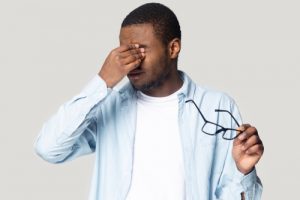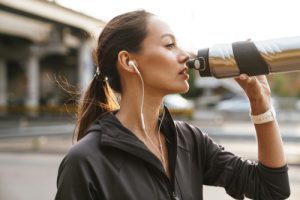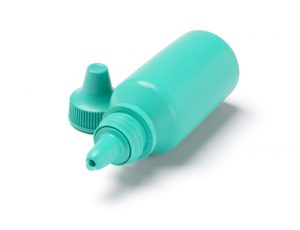Do your eyes feel dry, irritated, or tired? You may have a condition called dry eye syndrome.
Dry eye syndrome is a chronic eye condition that millions of people get diagnosed with yearly. As a result, having dry eyes is very common and can be triggered by several things.
If you’ve ever had dry eyes, you know how uncomfortable they can be. Dehydration can undoubtedly contribute to dry eye, and its frustrating symptoms, especially temporary dry eye.
But hydration alone isn’t always enough to alleviate your symptoms. Hydration can be a part of dry eye treatment, but you should consult with your ophthalmologist about your symptoms and ask for their treatment recommendations.
Many forms of treatment for dry eye are simple lifestyle changes and home remedies. Sometimes, however, you may need more intensive treatment from your eye care professional.
Before seeing an eye doctor, it can be helpful to know what dry eye is, what it feels like, and what can cause it. Keep reading to learn more about dry eye and how hydration can be a valuable part of your treatment regimen!
What are Dry Eyes and Why Do They Occur?

Dry eyes occur when your eyes aren’t producing enough tears or the tears created are not good quality. Many things can contribute to having tears that can’t lubricate and moisturize your eyes, leaving them feeling dry and irritated.
All tears have three parts: water, mucus, and oil. When the balance of these components is no longer in sync, it’s hard for your tears to moisturize your eyes adequately. You may have too much water in your tears, or you may not have enough oil. If these components aren’t right, your eyes can feel dry and cause you ongoing discomfort.
The most common symptom of having dry eyes is a burning, gritty feeling in the eyes. You may also experience redness, irritation, watering, and difficulty wearing contact lenses.
You likely have dry eyes if you experience these symptoms over an extended period.
Temporary vs. Chronic Dry Eye
Dry eyes can be temporary and triggered by your environment. Dry air may cause your tears to evaporate too quickly.
Improper contact lens use can also lead to dry eyes, like leaving them in for longer than you should or not using enough solution. You may even have dry eyes if you’re dehydrated.
If your dry eye is temporary, your symptoms will eventually dissipate if you eliminate their cause. But chronic dry eye, or dry eye syndrome, may not have a clear cause.
Due to this, your symptoms may persist for a long time if not adequately treated. Hormonal changes or another medical condition may cause dry eye syndrome. It’s also more common in women and older adults.
You may also develop dry eye symptoms if you take certain medications. But the only way to know what’s causing your dry eyes is to see your eye doctor.
When to See an Eye Doctor About Your Dry Eye Symptoms

If you experience dry eye symptoms that persist for more than a few days, you should see your eye care professional. You may have a temporary case of dry eye, but you may also have chronically dry eyes.
At Sierra Nevada Eye Center, our eye doctors can diagnose your dry eye using Tearlab. TearLab is a test that measures the quantity and quality of your tears.
With the information obtained by Tearlab, your eye doctor can recommend the best treatment to treat and improve your dry eye symptoms.
Treatment for Dry Eyes
Home remedies and lifestyle changes are some of the best techniques for treating dry eyes. Consult your eye doctor before trying any of these treatments, but know that they’re likely to suggest the following:
Hydration

If you’re feeling thirsty, it may be a sign that you’re dehydrated. If you’re dehydrated, that may also be a sign that your eyes are. Staying hydrated is a crucial part of treating dry eyes.
If you’re dehydrated, it’s harder for your eyes to produce tears. But drinking enough water is just part of a well-balanced treatment for dry eyes.

Lid Hygiene
The root cause of your dry eyes may be inflammation. The best way to ease inflammation is through proper lid hygiene. Practicing proper eyelid hygiene means keeping your eyelids clean.
You can do this by using a warm, wet compress over the eyes or various eye scrubs and eye wipes. Be sure to ask your eye doctor what they recommend you should use to keep your eyelids clean.
Nutrition
Poor nutrition can contribute to dry eyes. Omega-3 fatty acids are essential to having healthy tears.

You can find this nutrient in fatty fish, walnuts, flax seeds, and chia seeds. Dark, leafy greens also contain various nutrients that help keep your eyes healthy.
OTC Eye Drops
Over-the-counter artificial tears, or lubricating eye drops, can give you quick relief. But they’re only one part of long-term dry eye treatment.
Lifestyle changes, like a better diet and following lid hygiene, tend to help more over the long term. You may also find that it takes a combination of small lifestyle changes and medication to get the relief you need.
Prescription Medications or Surgical Procedures

If these simple treatments don’t alleviate your symptoms, your ophthalmologist at Sierra Nevada Eye Center may recommend more intensive treatment. These may include prescription medication or minimally invasive surgery.
Punctal occlusion, a procedure used to block off your tear ducts, often helps dry eyes when other treatments haven’t been successful. Plugging your tear ducts forces your tears to stay on the surface of your eye longer, compensating for poor tear quality.
You can find relief from the uncomfortable symptoms of having dry eyes with proper treatment. But to get appropriate treatment, you need to see an eye doctor for a diagnosis. After receiving your diagnosis, you and your eye doctor can work together to find a treatment plan that works for you.
Do you think that you may have dry eyes? Request an appointment at Sierra Nevada Eye Center in Carson City, NV, today! It’s time to get the relief you’ve been looking for.


